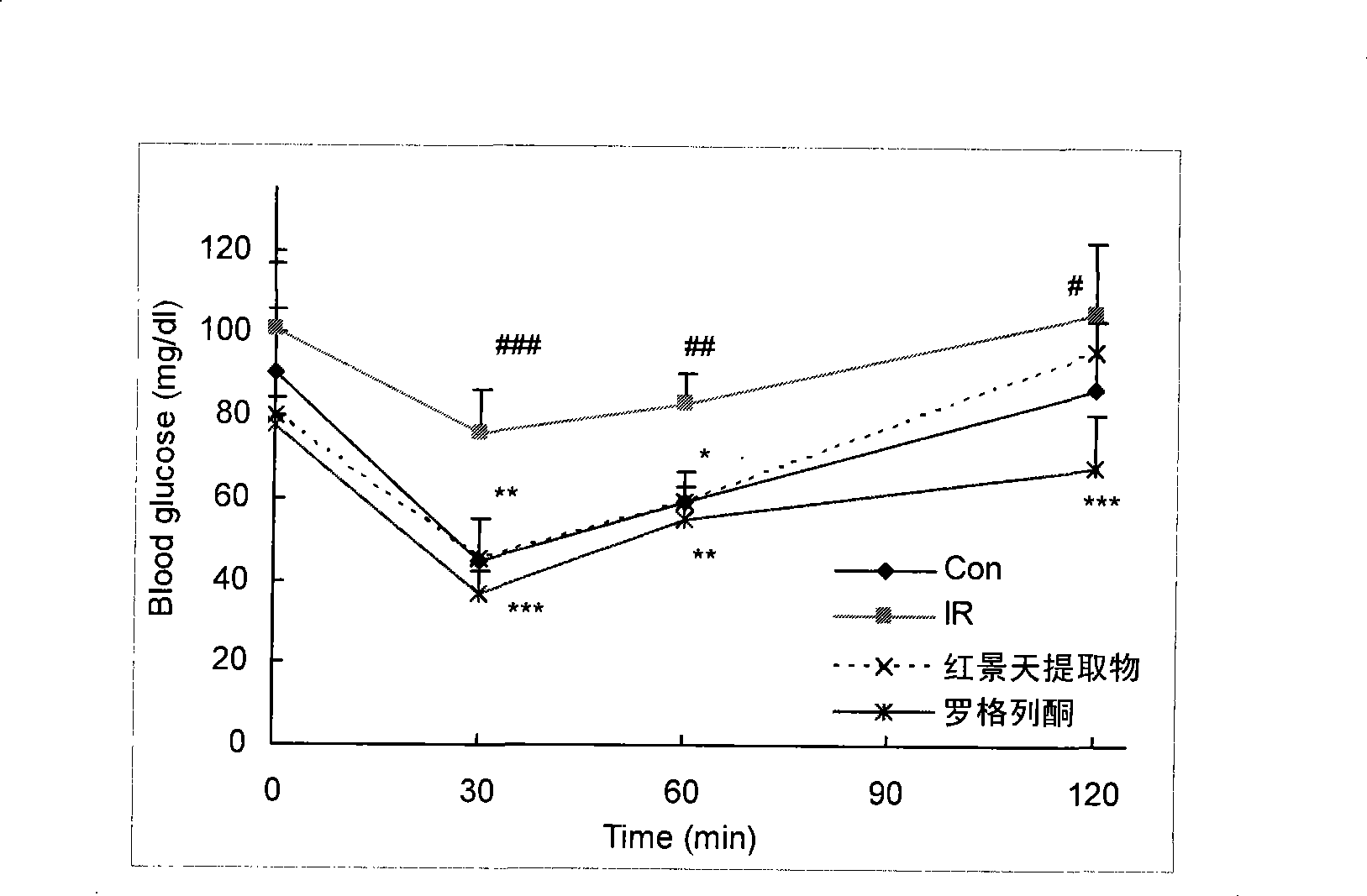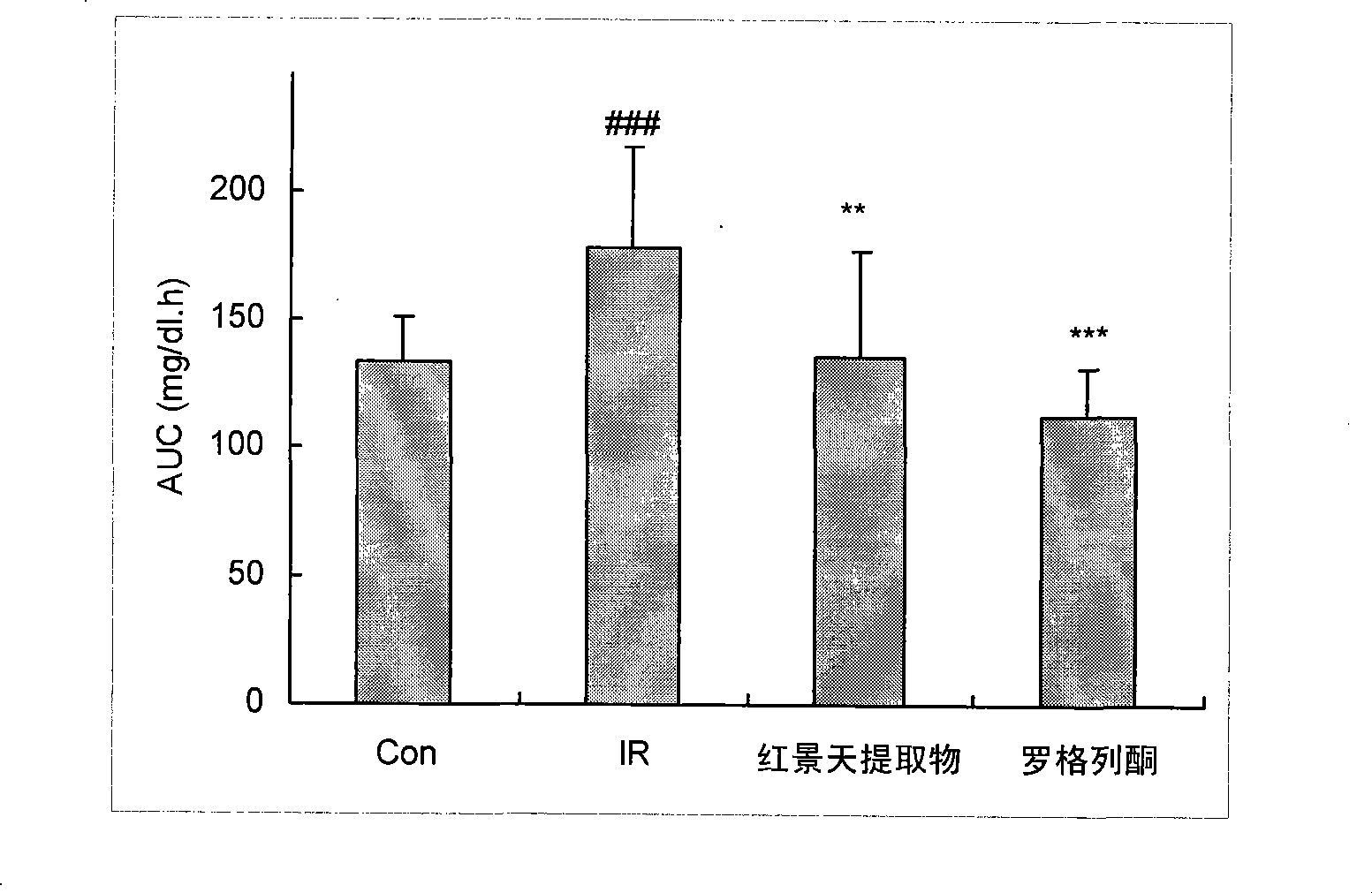Uses of rhodiola rosea in preventing and treating insulin resistance, and correlated metabolism diseases
A technology for insulin resistance and metabolic diseases, which is applied in the field of Rhodiola for the prevention and treatment of insulin resistance and related metabolic diseases, and can solve the problems of high incidence of adverse reactions, stimulation, application restrictions, etc.
- Summary
- Abstract
- Description
- Claims
- Application Information
AI Technical Summary
Problems solved by technology
Method used
Image
Examples
Embodiment 1
[0046] Example 1. Effect of Rhodiola Rosea Extract on Insulin Tolerance in Insulin-resistant IR Mice
[0047] method:
[0048] C57BL mice were fed with high-fat and high-sugar diet to form insulin resistance mouse model (IR). The model animals were randomly divided into 3 groups, respectively the model animal control group (IR), the positive control drug rosiglitazone group (rosiglitazone), and the Rhodiola rosea extract group, respectively oral water, rosiglitazone 15mg / kg, and Rhodiola rosea extract 2g / kg. At the same time, the same batch of normal animals fed with normal feed were set as the normal control group (Con). Inject 0.4U / kg insulin subcutaneously to the animals, observe the change of blood glucose after insulin loading, and calculate the area under the blood glucose-time curve (AUC), that is, the insulin tolerance test (ITT).
[0049] result:
[0050] Insulin-resistant animals were administered continuously for 10 days, and ITT experiments were carried out. ...
Embodiment 2
[0051] Example 2. Effect of Rhodiola rosea extract on oral glucose tolerance in insulin resistant IR mice
[0052] method:
[0053] C57BL mice were fed with high-fat and high-sugar diet to form insulin resistance mouse model (IR). The model animals were randomly divided into 3 groups, respectively model animal control group (IR), rosiglitazone group, and Rhodiola rosea extract group, respectively oral water, positive control drug rosiglitazone 15mg / kg, and Rhodiola rosea extract group. Daily extract 2g / kg. At the same time, the same batch of C57BL mice were fed with normal feed as the normal control group (Con). After continuous administration for 7 days, 2 g / kg of glucose was administered orally to animals, and the changes of blood glucose after glucose loading were observed, and the area under the blood glucose-time curve (AUC) was calculated, namely oral glucose tolerance test (OGTT).
[0054] result:
[0055] The results show that( image 3) , Compared with Con, the b...
Embodiment 3
[0056] Example 3. Effect of Rhodiola Rosea Extract on Glucose Infusion Rate GIR at Steady State in Ecglucose Clamp Experiment of Insulin Resistance IR Mice
[0057] method:
[0058] C57BL mice were fed with high-fat and high-sugar diet to form insulin resistance mouse model (IR). The model animals were randomly divided into 3 groups, respectively model animal control group (IR), rosiglitazone group, and Rhodiola rosea extract group, respectively oral water, positive control drug rosiglitazone 15mg / kg, and Rhodiola rosea extract group. Daily extract 2g / kg. At the same time, the same batch of C57BL mice were fed with normal feed as the normal control group (Con). Continuously administered for 20-25 days, a hyperinsulinemic clamp (orthoglycemic clamp) experiment with normal glucose levels was performed. That is, the animals were fasted for 4 hours, weighed, anesthetized by intraperitoneal injection of pentobarbital sodium, fixed on a 37°C constant temperature plate, surgically...
PUM
 Login to View More
Login to View More Abstract
Description
Claims
Application Information
 Login to View More
Login to View More - R&D
- Intellectual Property
- Life Sciences
- Materials
- Tech Scout
- Unparalleled Data Quality
- Higher Quality Content
- 60% Fewer Hallucinations
Browse by: Latest US Patents, China's latest patents, Technical Efficacy Thesaurus, Application Domain, Technology Topic, Popular Technical Reports.
© 2025 PatSnap. All rights reserved.Legal|Privacy policy|Modern Slavery Act Transparency Statement|Sitemap|About US| Contact US: help@patsnap.com



